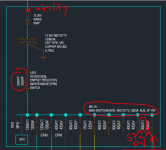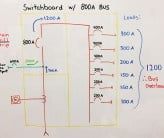This is informally known as "the 120% rule". The substance of the rule has been the same since NEC2014, but the reference of the rule has moved around, due to this section being reorganized. Prior to 2014, it was PV breaker + Main breaker <= 120% busbar. NEC2014 and later, they replaced PV breaker with the calculation that sizes the breaker, prior to rounding up to the size you are actually using.
In your example, I'm going to set B for busbar rating as a variable. It was given at 2500A, but 2500A is insufficient.
In 2011 and prior, the correct equation would've been 800A + 2500A <= 120% * B. This would calculate a minimum of B= 2750A.
In 2014 and later, the correct equation now becomes (125% * 572A) + 2500A <= 120% * B. This would calculate minimum B = 2670A. As you an see, 125%*572A is how we size the 800A breaker, with rounding up to a standard size being the next step. Except instead of using the value that rounds to 800A, we use the output of the calculation that sized the 800A breaker, prior to rounding to 800A
See the graphics from this source, that give you a better visual understanding of the equations the code gives:
2014 NEC 705.12(D)(2) - A new 120% rule... and more

www.purepower.com
Option B is the "120% rule", that allows you to take credit for feeding at the opposite end of the bus from the main supply. You get to have 20% of the busbar rating as headroom to interconnect, assuming you have a main that matches your busbar.
View attachment 2557362
The reason we get to do this, is that current in opposite directions is subtractive, rather than additive. At no point along the busbar, will current ever exceed 2500A or 800A in your example. The 800A feeds the nearest loads until it diminishes to zero. Then the main supply fills in the rest. The reason why it isn't as permissible as a 200% rule, as Kirchhoff's current law alone would seemingly allow, is mutual heating among the breakers. 120% is an industry compromise, that sets the limit for how much you can take credit for feeding the busbar from opposite ends, in order to mitigate the risk of overheating the branch breakers. If you want to increase the PV interconnection beyond 500A of OCPD (i.e. 400A of total inverter current), you either need to reduce your main breaker, or increase your busbar.
You can supply loads from both sources simultaneously, and in concept, it could draw the total from the main supply, plus the PV production. However, you still have the same load calculation to size the main breaker, as if the solar weren't there. You don't want to trip your main breaker on a plausible amount of building load at the peak demand, just because an inverter isn't working. Reducing the size of your main breaker is one strategy to allow a larger interconnection, but you have a burden of proof if you desire to do so. Either with a load calculation, or with 30 days of interval power data.
Adding the solar will allow the system to draw over 3000A in your example, in the event that you consume more instantaneous power than the load calculation predicted, and it allows you to do so without tripping your main. It will not add up to 3000A at any cross-section of the busbar, because opposite directions of current are not additive. This is an unlikely event, because rules that govern how to size a service/main feeder to a loads panelboard require you to make it an unlikely event.




